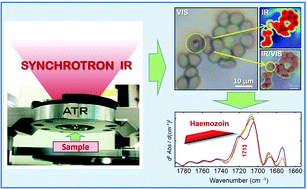Synchrotron macro ATR-FTIR microspectroscopy for high-resolution chemical mapping of single cells†
Abstract
Attenuated total reflection Fourier transform infrared (ATR-FTIR) spectroscopy has been used widely for probing the molecular properties of materials. Coupling a synchrotron infrared (IR) beam to an ATR element using a high numerical aperture (NA) microscope objective enhances the spatial resolution, relative to transmission or transflectance microspectroscopy, by a factor proportional to the refractive index (n) of the ATR element. This work presents the development of the synchrotron macro ATR-FTIR microspectroscopy at Australian Synchrotron Infrared Microspectroscopy (IRM) Beamline, and demonstrates that high quality FTIR chemical maps of single cells and tissues can be achieved at an enhanced spatial resolution. The so-called “hybrid” macro ATR-FTIR device was developed by modifying the cantilever arm of a standard Bruker macro ATR-FTIR unit to accept germanium (Ge) ATR elements with different facet sizes (i.e. 1 mm, 250 μm and 100 μm in diameter) suitable for different types of sample surfaces. We demonstrated the capability of the technique for high-resolution single cell analysis of malaria-infected red blood cells, individual neurons in a brain tissue and cellular structures of a Eucalyptus leaf. The ability to measure a range of samples from soft membranes to hard cell wall structures demonstrates the potential of the technique for high-resolution chemical mapping across a broad range of applications in biology, medicine and environmental science.

- This article is part of the themed collection: Next wave advances in single cell analyses


 Please wait while we load your content...
Please wait while we load your content...